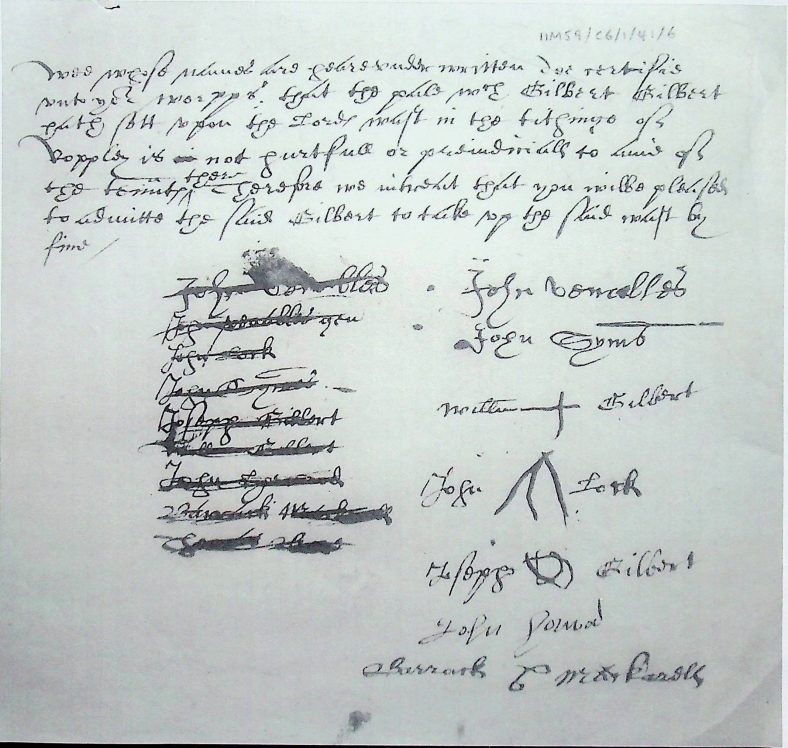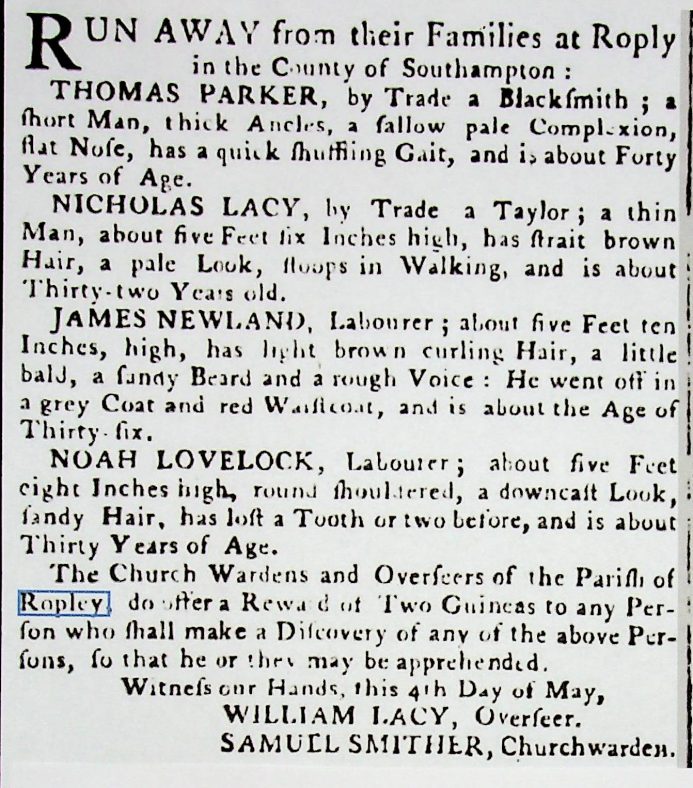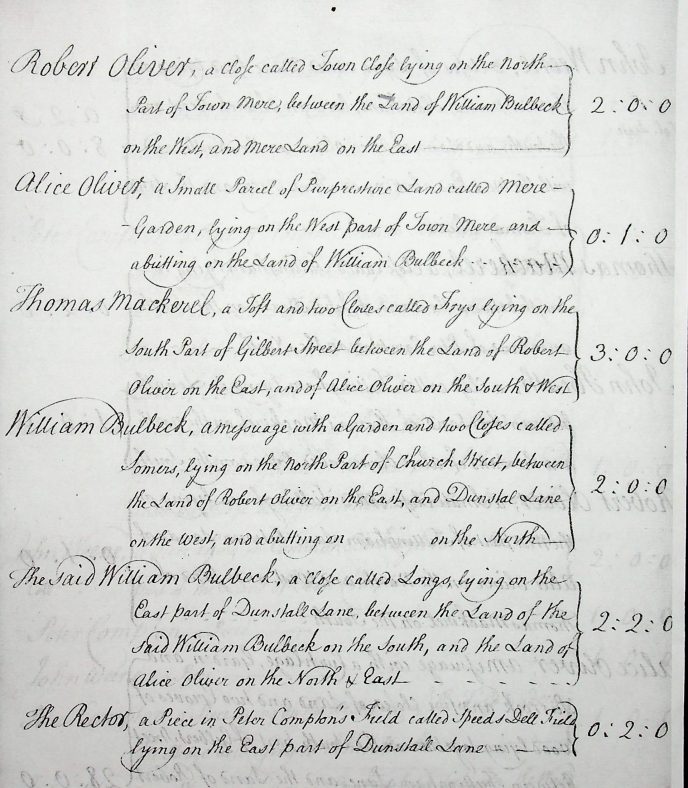History of the Village Centre project 2020/21
Finding out as much as we can about the past in the heart of old Ropley has been an exciting project, involving not just the history of the houses but the stories of all those generations who have lived there over the centuries.
Both of us live in adjoining adjacent cottages close to both the church and one of the old village ponds. We started some years ago to see if we could discover when they were built, who the first owners were and who has lived there since.
In finding out their stories, we have been able to piece together a picture of the village as it endured the traumatic events of the civil war, the plague, enclosures and threatened invasions in both the early 19th and 20th centuries, together with periods of relative prosperity, poverty and food riots. Little Ropley may have been off the beaten track for much of its existence but outside events have had a real impact on the lives of ordinary villagers.
We believe our cottages were built by a Gilbert Gilbert, in about 1613. The Gilberts were an old family connected with the village for centuries. We have worked out a timeline showing at least most of the owners or occupiers from then up to the present. From affluent yeoman farmers in the 17th century to a rough alehouse in the 19th century, and from creditors at the door in the 1700’s to a village shoemaker for decades in the 1800’s, our cottages have reflected the changing ways of life of the village as a whole.
In our research, we have been greatly helped by being located so close to the pond at the top of Church Street. It can be very hard to identify a building in old documents before the days of house numbers (or indeed house names) but as our deeds have always used the same description of the location – i.e. “lying on the west part of the village of (sic) mere” or pond, we believe we have been able to identify our cottages despite the legal jargon and old style handwriting.
Because of the frequent mention of the pond in deeds, we know it was certainly there by about 1700. In fact, as there are references to “mere garden” in the 1600’s, it may well be even older. We think the pond was originally man made, dug out to possibly fertilise the surrounding fields and naturally filled by rainwater and dew. It was one of many in and around the village, including one opposite the old forge which was used by the local blacksmiths.
Our future plans are to find out whatever more we can to paint as detailed a picture of old Ropley as possible. Our task has certainly been made easier by the material now available on the Ropley History website. Plans showing Town Street Fame give a great picture of the land around our cottages nearly 100 years ago.
Presented below are a series of the old documents and references that we have uncovered during our search.
Who was who in Ropley in 1612
The signatures or marks of some of the locals confirming they had no objection to Gilbert Gilbert fencing off part of “the Lords waste i the tything of Ropley”. This allowed Gilbert to go to the court of the Lord of the manor in Bishop’s Sutton to aquire unused waste land on which to build his house.
First Title Deeds
Copy of the Manorial Fines Book entries of 1612 showing Gilbert Gilbert was given permission from the Lord of the Manor to take over the “waste” land and entering his name as the first owner.
The reference to “Meere gardens” suggests the village pond existed in some form at this time.
Early Owners
Manorial Fines Book entries showing Thomas Budd acquired Meere garden from Robert Weene in 1658, with Thomas’s son following him in 1673 and Willian Yalden, the son of Robert Yalden taking over in 1677.
Deserting Husbands
Deserting husbands left behind wives and children who became dependent on Parish Poor Law Relief, tracing them was a job for the Parish Overseer and church Wardens. In this example Samuel Smither owned (but probably did not occupy) Bell Cottage and Five Bells from 1779 to 1809.
Who owned what in Ropley in the 1780’s
Alice Oliver was in Bell Cottage / Five Bells, but probably not as an owner / occupier.
Town Close, Dunstall Lane, Church Street all mentioned.
One of the Ropley smugglers
Copy of an article from the Hampshire Chronicle of 27th October 1823 reporting the conviction of Thomas Budd for being in possession of 28 gallons of foreign brandy in Bishops Waltham.















Comments about this page
Thanks Annie. We’d love to see your deeds and take a copy of them. Sounds like they would help us build further on the information we have on the old centre of the village. We are now running our Thursday afternoon workshops every 2 weeks, the next on is 2 – 4pm on Thursday 2nd Feb then every 2 weeks in the back room at the Parish Hall. Maybe you could pop in on one of these ? Thanks Carole
Phillippa many thanks for that and how interesting. I will pass your details on to the team who did the research on this. They may have further information that can help you.
Fascinating information! I wonder if Noah Lovelock was a relative as I have Lovelocks on my mothers side. Wikitree states:
Noah was born in 1739. He is the son of Noah Lovelock and Ann Susanah Finden. He was christened on 13 Jan 1739/40 in Ropley, Hampshire, England. He married Ann Forder on 6 Oct 1769 in Swarraton, Hampshire, England. She passed away in Ropley In 1773 and was buried with their three dead children.
Brilliant article!
Fascinating – we are, of course, living in the Old Gilbert Street Farmhouse. We have copies of old deeds showing a connection between Gilbert Street Farm and Town Street Farm.
Add a comment about this page